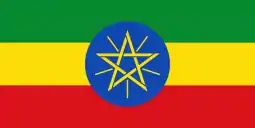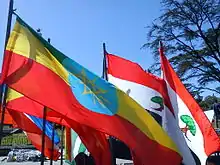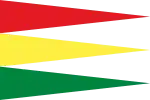Flag of Ethiopia
The national flag of Ethiopia (Amharic: የኢትዮጵያ ሰንደቅ ዓላማ, yä-Ityoṗya SändäqʿAlama; Oromo: Alaaba biyyaalessa Itiyoophiyaa) is a green, gold, and red tricolour with the National Emblem, a golden pentagram on a blue disc, superimposed at the center. While the colors green, gold, and red in combination held symbolic importance since at least the early 17th century, the modern tricolor was first adopted on 11 October 1897, and the present flag on 31 October 1996.[1][2]
 | |
| Use | National flag and ensign |
|---|---|
| Proportion | 1:2 |
| Adopted | 11 October 1897 (original version) 31 October 1996 (current, modified 16 May 2009) |
| Design | A horizontal tricolour of green, yellow and red with the National Emblem superimposed at the center. |
| Designed by | Abebe Alambo |
Colours

The Green, Yellow and Red were used for the flag of the Ethiopian Empire in 1914.[1] On 11 October 1897, a year after Ethiopia decisively defended itself from Italian colonization at the Battle of Adwa, emperor Menelik II ordered the three pennants combined in a rectangular tricolour from top to bottom of red, yellow, and green with the first letter of his own name (the Amharic letter "ም") on the central stripe.[2][3][4][5] In 1914, the current flag was brought back.[1] The flag's tri-colour scheme has existed since the early 19th century, and the colours red, yellow, and green have carried special importance since at least the early 17th century.[6] To commemorate its adoption in 1897, Ethiopia celebrates Flag Day on the first Monday of the month of Tikimt (September–October).[7]
The royal flag often featured the emblem of a Lion of Judah, a crowned lion carrying a cross centred in the banner's yellow midsection. The flag is understood to be a link between the Ethiopian Orthodox Tewahedo Church, the peoples, and the nation that was united. The processional cross carried by the lion was the former flag or symbol of Ethiopia, and has likewise been in use since at least the early 17th century.[8] Whilst red is currently featured at the bottom of the horizontal tricolour, this was reversed until the mid-19th century. The emblem was added in 1996. What the colours symbolise varies depending on point of view. However, generally, red represents blood spilled in defence of Ethiopia; yellow represents peace and harmony between Ethiopia's various ethnic and religious groups; and green is said to symbolise hope, or the land and its fertility.
Upon gaining independence from colonial rule, several newly established countries in Africa adopted these three colours in homage to Ethiopia's resistance against foreign occupation. When adopted by Pan-Africanist polities and organisations for their activities, the colours are often referred to as the Pan-African colours.[9]
Colour and symbolism
- Green: "represents the richness and the fertility of our land as well as hope "
- Yellow: "represents religious freedom and peace."
- Red: "represents the sacrifice of our fathers, who spilled their blood in defense of Ethiopia "
(2009–present) |
Green | Yellow | Red |
|---|---|---|---|
| Pantone | 139c | 052c | 358c |
| CMYK | 95-0-65-46 | 0-12-96-1 | 0-92-88-15 |
| RGB | 7-137-48 | 252-221-9 | 218-18-26 |
| Hexadecimal | #078930 | #FCDD09 | #DA121A |
(1996–2009) |
Green | Yellow | Red |
|---|---|---|---|
| Pantone | 139c | 052c | 358c |
| CMYK | 95-0-65-46 | 0-12-96-1 | 0-92-88-15 |
| RGB | 7-137-48 | 252-221-9 | 218-18-26 |
| Hexadecimal | #078930 | #FCDD09 | #DA121A |
Emblem
Prior to 1996, the plain green, yellow and red banner was commonly used as a civil flag. Although a number of different emblems were used by the government since 1974, flags with emblems were uncommonly used in public outside of government usage. The basic colour schematic has remained constant.
The star is yellow on a blue disc which overlaps the green and red stripes. The star testifies to Ethiopia's bright future, while the yellow rays which it emits are equidistant and are said to represent the equality of all Ethiopians regardless of race, creed, or sex. In recent years, the government of Ethiopia has taken a conscious effort to increase the usage of the flag with the emblem, which had been seen far less than the plain tricolour. As the plain tricolour was used and seen far more often than either the flag of the Derg or the Lion of Judah flag, this was considered unusual.
In 2009, the Parliament of Ethiopia passed Proclamation 654/2009 (The Federal Flag Proclamation), which prohibited firstly amongst 23 other provisions "use [of] the Flag without its Emblem", as well as "to deface the Flag by writing or displaying signs, [sic] symbols, emblems or picture [sic]", or "to prepare or use the Flag without the proper order of its colours and size or its Emblem."[17] While most offences were punishable by a fine of "3000 birr or rigorous imprisonment up to one year," the first offense, mandating the usage of the emblem, received an increased penalty of "5000 birr or rigorous imprisonment up to one year and six months."[17] This replaced the 1996 Flag Proclamation, which had made no mention of offenses or penalties.[18]
Historical flags
.svg.png.webp)
Reported flag from 1875–1881[19]

From 1881 to 1889 Ethiopia flew a Tricolor of Pennants
.svg.png.webp)
Flag of the Ethiopian Empire (1914–1936).[5]
_crowned.svg.png.webp)
Flag of Italian East Africa (1936–41)[20]
.svg.png.webp)
The flag with the Lion of Judah (1941–1974).[5] It remains popular with the Rastafari movement and people loyal to Haile Selassie.
.svg.png.webp)
War Ensign of the Imperial Ethiopian Navy (1955–1974), was based upon the Blue Ensign.
.svg.png.webp)
War Ensign of the Imperial Ethiopian Navy (1974–1975).
.svg.png.webp)
The official flag under the Derg (1975–1987), essentially the Imperial flag without the lion. It was seen more than the state flag.
_(02).svg.png.webp)
The state flag under the Derg (1975–1987). Rarely seen, and a forerunner to the flag introduced in 1987.
.svg.png.webp)
The flag of the People's Democratic Republic of Ethiopia (1987–1991) introduced the current ratio of 1:2.
.svg.png.webp)
The flag of the Transitional Government of Ethiopia (1991–1996). It is the same as the 1975–1987 official flag, except for the ratio.
.svg.png.webp)
The state flag of the Transitional Government of Ethiopia, adopted on 28 May 1992.[5]
.svg.png.webp)
The flag of the Federal Democratic Republic of Ethiopia from 6 February[18] to 31 October 1996.[22] Its central disc is smaller and brighter than in the current flag.
.svg.png.webp)
Flag from 1996 to 2009.

The current flag, used since 2009.
References
- Firefly Books Firefly Guide to Flags of the World – Google Books" Firefly Books, 2003. p. 74.
- Flag Research Center Firefly The Flag Bulletin, Volume 27 – Google Books" Flag Research Center, 1988. p. 11.
- Michael B. Lentakis Ethiopia: A View from Within – Google Books" Janus Publishing Company Lim, 2005. p. 11.
- W. Mitchell Journal of the Royal United Service Institution, Whitehall Yard, Volume 41, Issue 2 – Google Books" 1897. p. 1190.
- "Vlajky a znaky Etiopie" [Flags and emblems of Ethiopia]. Vexilolog (in Czech) (8). 2003.
- Manoel Barradas, "Tractatus Tres Historico-Geographici: (1634); A Seventeenth Century Historical and Geographical Account of Tigray, Ethiopia", Elizabet Filleul, trans., Richard Pankhurst, ed., in Aethiopistische Forschungen 43. Wiesbaden: Harrassowitz, 1996, p. 59.
- "National Flag Day to be Observed on Monday". Ethiopian News Agency. 10 October 2019. Retrieved 22 December 2020.
- Barradas, pp. 70–71.
- Ethiopia
- "Man speaks during a vigil at Nathan Philips Square in Toronto,..." Getty Images. Retrieved 7 February 2021.
- Tefera, G.W.; Castro, A.P. (2016). "Flag Politics in Ethiopia and the Ethio-American Diaspora" (PDF). Journal of International and Global Studies. 8 (1): 15. Retrieved 7 February 2021.
- Alfa Shaban, Abdur Rahman. "Ethiopia's ex-rebel group Ginbot 7 returns from Eritrea base". Africanews. Retrieved 7 February 2021.
- "Ethiopia:Two prominent opposition parties form coalition ahead of election". Borkena Ethiopian News. 7 March 2020. Retrieved 7 February 2021.
|first1=missing|last1=(help) - "Ethiopia celebrates new year after 'God's wrath'". Al Arabiya English. 11 September 2020. Retrieved 7 February 2021.
- Carrington, Daisy; Harris, Aja. "Holy water washes away sins at Ethiopia's Timket festival". CNN. Retrieved 7 February 2021.
- Chapman, Mark. "Come & join the Timkat celebration in a Village in Ethiopia | Tesfa Tours". www.tesfatours.com. Retrieved 7 February 2021.
- "Proclamation No. 654/2009 – The Federal Democratic Republic of Ethiopia Flag Proclamation" (PDF). Federal Negarit Gazeta: 4843–4855. 28 August 2009.
- "Proclamation No. 16/1996 – A Proclamation on the Flag and Emblem of the Federal Democratic Republic of Ethiopia" (PDF). Federal Negarit Gazeta: 94–98. 6 February 1996.
- http://www.rbvex.it/africapag/etiopia.html
- https://www.vexilla-mundi.com/ethiopia_history.html (archived)
- People's Democratic Republic of Ethiopia (1974–1991)
- "Proclamation No. 48/1996 – A Proclamation to amend the Flag and Emblem Proclamation" (PDF). Federal Negarit Gazeta: 272–273. 31 October 1996.
External links
| Wikimedia Commons has media related to Flags of Ethiopia. |
.svg.png.webp)
.svg.png.webp)
.svg.png.webp)